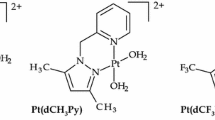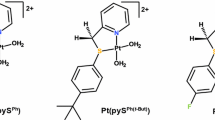Abstract
The rate of the chloride ligand displacement by three thiourea neutral nucleophiles (Nu) of different steric demands, namely thiourea (Tu), N,N’-dimethylthiourea (Dmtu) and N,N,N,’N-tetramethylthiourea (Tmtu) in the complex 2,6-bis(8-quinolyl)-pyridine chloroplatinum(II) (Pt3), was investigated under pseudo-first-order conditions as a function of concentration and temperature using UV–visible spectrophotometry and compared with the literature data of complexes: 2,6-bis(2-pyridyl)pyridine chloroplatinum(II) (Pt1), 1,3-bis(pyridyl)phenyl chloroplatinum(II) (Pt2) and 1,3-bis(8-quinolyl)phenyl chloroplatinum(II) (Pt4). The observed pseudo-first-order rate constants for substitution reactions obeyed the simple rate law \(k_{{{\text{obs}}}} = k_{2} \left[ {Nu} \right]\). The results demonstrated that the lability of the chloride ligand is dependent on the degree of synergy between electronic character and the planarity of architectural frame work of the ligands around the platinum centre. The second-order kinetics and large negative activation entropies (ΔS#) assert an associative mode of activation. DFT calculations were performed to support the interpretation and discussion of the experimental data.
Graphic abstract
The retardation in lability of quinoline systems; 2,6-bis(8-quinolyl)pyridine chloroplatinum(II) (Pt3) and 1,3-bis(8-quinolyl)phenyl chloroplatinum(II) (Pt4) is attributable to cis σ-donor effect and twisting of the quinoline rings that offsets the π-acceptor ability on the extended π-system. Conversely, high reactivity of pyridine systems; 2,6-bis(2-pyridyl)pyridine chloroplatinum(II) (Pt1) and 1,3-bis(pyridyl)phenyl chloroplatinum(II) (Pt2), is due to their rigid planar structure that facilitates effective π-acceptor ability.






Similar content being viewed by others
References
Shen D-W, Pastan I, Gottesman MM (1998) Cancer Res 58:268–275
Maheshwari V, Bhattacharyya D, Fronczek FR, Marzilli PA, Marzilli LG (2006) Inorgan Chem 45:7182–7190
Goldschmidt V, Jenkins LMM, de Rocquigny H, Darlix J-L, Mély Y (2010) HIV Ther 4:179–198
Du P, Schneider J, Li F, Zhao W, Patel U, Castellano FN, Eisenberg R (2008) J Am Chem Soc 130:5056–5058
Yu C, Chan KHY, Wong KMC, Yam VWW (2008) Chem Eur J 14:4577–4584
Wong KM-C, Tang W-S, Chu BW-K, Zhu N, Yam VW-W (2004) Organometallics 23:3459–3465
Cummings SD (2009) Coord Chem Rev 253:449–478
Develay S, Blackburn O, Thompson AL, Williams JG (2008) Inorgan Chem 47:11129–11142
Alibrandi G, Minniti D, Monsu Scolaro L, Romeo R (1988) Inorgan Chem 27:318–324
Frey U, Helm L, Merbach AE, Romeo R (1989) J Am Chem Soc 111:8161–8165
Wendt OF, Oskarsson Å, Leipoldt JG, Elding LI (1997) Inorgan Chem 36:4514–4519
Plutino MR, Monsù Scolaro L, Romeo R, Grassi A (2000) Inorgan Chem 39:2712–2720
Basolo F, Chatt J, Gray H, Pearson R, Shaw B (1961) J Chem Soc 2207–2215
Gosling R, Tobe ML (1983) Inorgan Chem 22:1235–1244
Canovese L, Tobe ML, Cattalini L (1985) J Chem Soc Dalton Trans 1:27–30
Cusumano M, Marriochi P, Romeo R, Ricevuto V, Belluco U (1979) Inorgan Chim Acta 34:169–174
Wendt OF, Elding LI (1997) Inorgan Chem 36:6028–6032
Romeo R, Plutino MR, Monsù Scolaro L, Stoccoro S, Minghetti G (2000) Inorgan Chem 39:4749–4755
Jaganyi D, Reddy D, Gertenbach J, Hofmann A, van Eldik R (2004) Dalton Trans 299–304
Garner KL, Parkes LF, Piper JD, Williams JG (2009) Inorgan Chem 49:476–487
Jaganyi D, Hofmann A, van Eldik R (2001) Angew Chem Int Ed 40:1680–1683
Hofmann A, Jaganyi D, Munro OQ, Liehr G, van Eldik R (2003) Inorgan Chem 42:1688–1700
Hofmann A, Dahlenburg L, van Eldik R (2003) Inorgan Chem 42:6528–6538
Reddy D, Jaganyi D (2006) Trans Metal Chem 31:792–800
Petrovic B, Bugarcic ZID, Dees A, Ivanovic-Burmazovic I, Heinemann FW, Puchta R, Steinmann SN, Corminboeuf C, Van Eldik R (2012) Inorgan Chem 51:1516–1529
Ongoma P, Jaganyi D (2012) Dalton Trans 41:10724–10730
Wekesa IM, Jaganyi D (2016) J Coord Chem 69:389–403
Price JH, Williamson AN, Schramm RF, Wayland BB (1972) Inorgan Chem 11:1280–1284
Jäger M, Smeigh A, Lombeck F, Görls H, Collin J-P, Sauvage J-P, Hammarström L, Johansson O (2009) Inorgan Chem 49:374–376
Barder TE, Walker SD, Martinelli JR, Buchwald SL (2005) J Am Chem Soc 127:4685–4696
Appleton TG, Hall JR, Ralph SF, Thompson CS (1984) Inorgan Chem 23:3521–3525
Lee C, Yang W, Parr RG (1988) Phys Rev B 37:785
Hay PJ, Wadt WR (1985) J Chem Phys 82:270–283
Becke AD (1993) J Chem Phys 98:5648–5652
Evans MG, Polanyi M (1935) Trans Faraday Soc 31:875–894
Schiessl WC, Summa NK, Weber CF, Gubo S, Dücker-Benfer C, Puchta R, van Eikema Hommes NJ, van Eldik R (2005) Zeitschrift für anorganische und allgemeine Chemie 631:2812–2819
Murray SG, Hartley FR (1981) Chem Rev 81:365–414
Ashby MT (1990) Comments Inorgan Chem 10:297–313
Reedijk J (1999) Chem Rev 99:2499–2510
Constable E (1986) Adv Inorgan Chem 30:69–121
Vezzu DA, Ravindranathan D, Garner AW, Bartolotti L, Smith ME, Boyle PD, Huo S (2011) Inorgan Chem 50:8261–8273
Schmülling M, Grove DM, van Koten G, van Eldik R, Veldman N, Spek A (1996) Organometallics 15:1384–1391
Van Eldik R (1994) J Chem Soc Dalton Trans 1257–1263.
Ryabov AD, Kuzmina LG, Polyakov VA, Kazankov GM, Ryabova ES, Pfeffer M, Van Eldik R (1995) J Chem Soc Dalton Trans 6:999–1006
Kapoor P, Kukushkin VY, Lövqvist K, Oskarsson Å (1996) J Organometal Chem 517:71–79
Sauvage JP, Collin JP, Chambron JC, Guillerez S, Coudret C, Balzani V, Barigelletti F, De Cola L, Flamigni L (1994) Chem Rev 94:993–1019
Sanderson R (1954) J Chem Edu 31:238
Jaganyi D, Tiba F, Munro OQ, Petrović B, Bugarčić ŽD (2006) Dalton Trans 24:2943–2949
Cooper J, Ziegler T (2002) Inorgan Chem 41:6614–6622
Rindermann W, Palmer D, Kelm H (1980) Inorgan Chim Acta 40:179–182
Kinunda G, Jaganyi D (2014) Trans Metal Chem 39:451–459
Onunga DO, Jaganyi D, Mambanda A (2019) J Coord Chem 1–15
Acknowledgements
The authors are gratefully indebted to the University of KwaZulu-Natal and the National Research Foundation (NRF, South Africa) for bursary to I.M. Wekesa and financial support.
Author information
Authors and Affiliations
Corresponding author
Ethics declarations
Conflict of interest
The authors declare that they have no conflict of interest.
Disclosure Statement
No potential conflict of interest was reported by the authors.
Additional information
Publisher's Note
Springer Nature remains neutral with regard to jurisdictional claims in published maps and institutional affiliations.
Supplementary Information
Support information (ESI) available. Selected mass and NMR spetra, wavelengths for kinetic measurements for complex Pt3. Below is the link to the electronic supplementary material.
Rights and permissions
About this article
Cite this article
Wekesa, I.M., Jaganyi, D. The electronic effect of quinoline moieties on the lability of platinum(II) complexes of tridentate N^N^N and N^C^N ligands: a kinetic, mechanistic and theoretical analysis. Transit Met Chem 46, 363–371 (2021). https://doi.org/10.1007/s11243-021-00454-8
Received:
Accepted:
Published:
Issue Date:
DOI: https://doi.org/10.1007/s11243-021-00454-8




